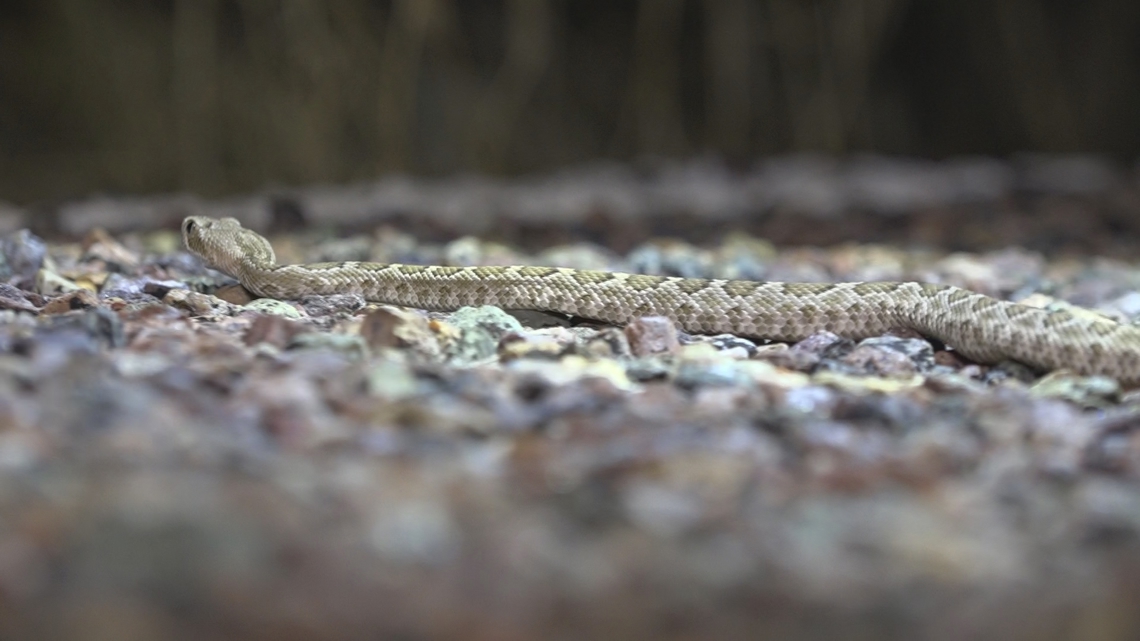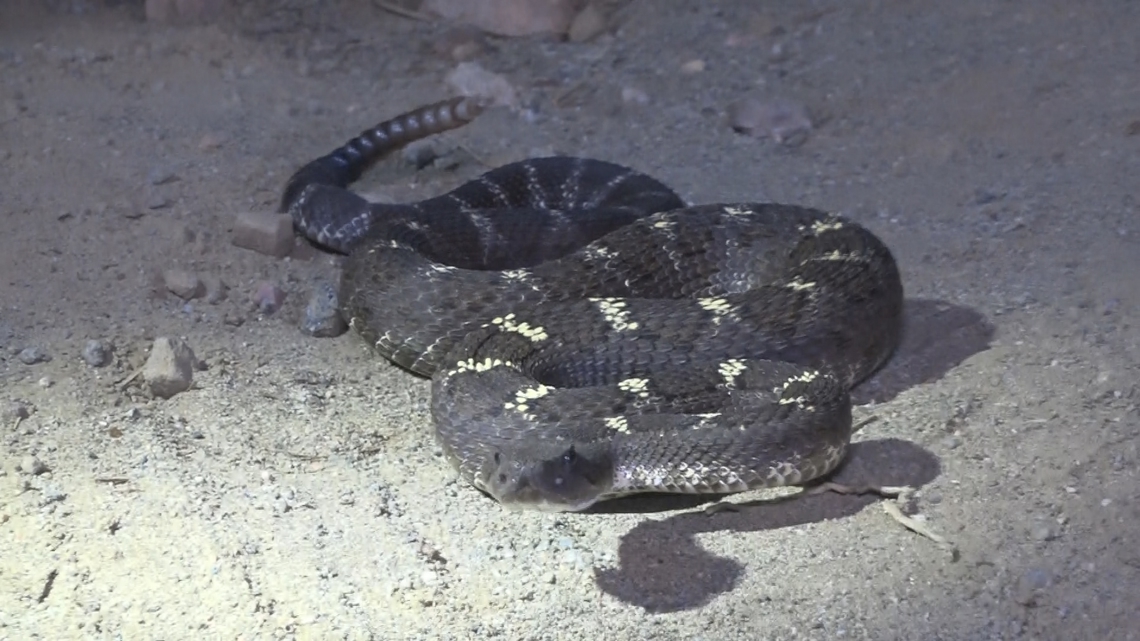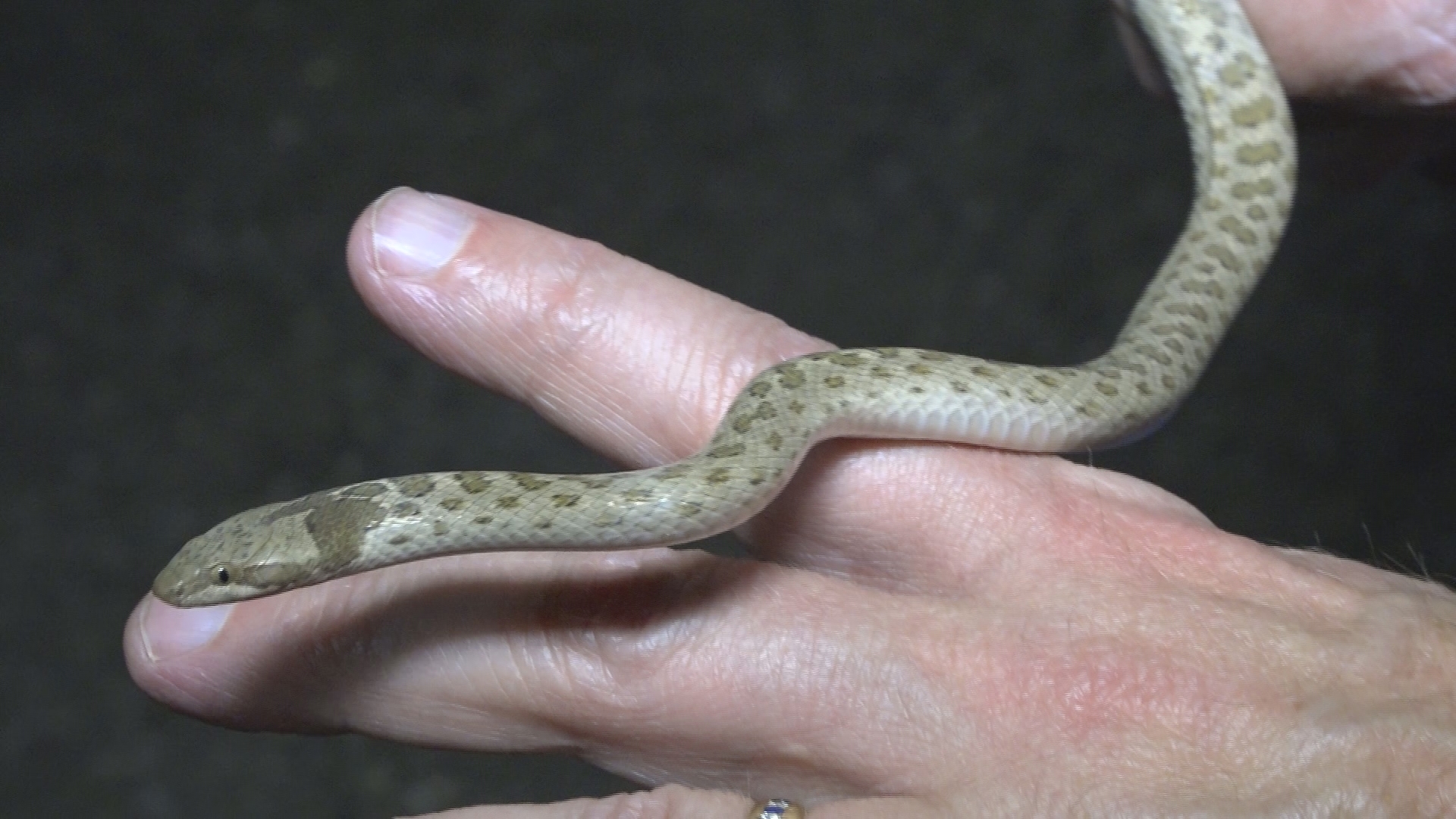GILA COUNTY, Ariz. — It is 7:34 p.m. on a Saturday when we arrive at a secret location in Gila County. It’s a dirt parking lot surrounded by rocky hills.
Jaren Martineau is protective of this less traveled desert road. He doesn’t want crowds of people to spoil it, or reptile poachers to take advantage of it.
Alongside Martineau are two of his childhood friends. One of them, Jason Tenney, is wearing shorts and flip flops —not attire you would expect for what we are about to do and what we hope to encounter.
The four of us hop into Tenney’s truck and slowly cruise down the road as the sun sets and the desert gets dark.
We are looking for creatures that give people nightmares. And just like bad dreams, they are most common at night.
“We are herping right now,” Tenney said.
They say the early bird gets the worm but if you want to find a snake or a big hairy spider in the Arizona desert, you need to be a night owl.
But Martineau and his friends prefer to call themselves something else — they are “herpers” and they go “herping” whenever the weather — and their wives — allow it.
Herping is the act of looking for reptiles and amphibians, known as herps. Herpetology is the study of them.
Martineau, a lawyer by day, has been herping since he was a child. He got hooked on catching lizards.
“As I got older, I discovered that I wanted more than just lizards, I wanted some snakes, but of course, mom was not going to have anything of the sort,” he said.
Then he turned 18, got his first car and some freedom. Martineau started reading reptile guidebooks and learned of an easy way to find snakes in the desert. All you need is a car, the right location and conditions.
“Definitely during the summer monsoon, nighttime is probably the easiest way to find most reptile and amphibians,” Martineau said.
That night, it didn’t take long to find our first herp, which, at first, looked more like a stick in the road. It turned out to be a baby Mohave rattlesnake.


“This time of year is typically when the babies are born,” Martineau said, as he maneuvered his snake hook. The rattlesnake didn’t hiss or rattle — it just wanted to get away. Martineau gently coaxed it off the road with a pink snake hook.
Snakes that hang out on the pavement run the risk of getting squished. Martineau calls these DORs, or “dead on the roadway."
Dead snakes don’t get you any points in his Facebook group’s annual monsoon herping challenge.
Yes, that is a thing.
The group, “ARIZONA Reptiles and Amphibians – Herping, Community, Observations,” has grown to 2,600 members. People post what they find and some ask for help identifying a snake.
“It seemed like some of the other Facebook groups were a little less friendly to people that are new to the hobby,” Martineau said. “So I started mine as a way to ease people into it.”
Martineau also has a YouTube channel, “Sonoran Herping Adventures,” where he documents his herping trips and shares tips on how to have a successful outing.
Saturday night’s herping was successful.
Less than a mile from where we encountered the baby Mohave rattlesnake, a Sonoran gopher snake was stretched out in the middle of the road.
As we got out of the truck, we saw something else: Headlights approaching.
“We got a car. Do you want me to grab it?” Tenney asks.
Tenney picks up the non-venomous snake and the driver stops, probably wondering what four guys with flashlights are doing on the side of the road, especially this one.
“Everything alright?” the stranger asks. “Yep, thank you,” Martineau responds. The car drives on.
The Sonoran gopher snake Tenney is holding is roughly 2 feet long, although Martineau said they can grow up to 7 feet.
“They eat a lot, they just eat a ton of rodents,” Martineau said.
The second gopher snake we later found looked like something tried to eat it. It had a wound that was healing. We offered it water, but the rodent-killing snake wasn’t thirsty. It slithered off the road and into some brush. It wanted nothing to do with us.
None of these herps did.
“A lot of people are fearful that if they see one, it is going to chase them and that is typically not what you are going to see,” Martineau said. “Most of the time, if a snake sees you, it is going to remain motionless and hope that you don’t see it, or it is going to look for a way to escape as soon as it possibly can.”
We kept driving, then Tenney slammed on the brakes once again.
“That’s a banded gecko or something out your door,” he said.
We weren’t quick enough.
Further down the road, we came to a halt once again. It looked like a snake. Martineau got out to investigate.
“Yeah, it’s a stick. It’s a root or something,” he says.
But what we found a few miles up the road was not a stick: It was an Arizona black rattlesnake.
These, like all 13 species of rattlesnakes found in Arizona, are venomous and potentially deadly.
Martineau has never been bitten and said he never expects to. He gives this Arizona black rattlesnake plenty of space and respect.
“I think this is one of the more beautiful rattlesnakes that we have,” Martineau said.


During our three-and-a-half-hour herping adventure, we found five different species of rattlesnake, two Sonoran gopher snakes, a Sonoran desert toad, two skunks, a coyote pup and a tarantula. Sure, the last three critters we listed technically aren’t herps, but they were neat to see.
Herping was surprisingly fun and simple. It’s a relatively inexpensive hobby, but again, you need to have the right conditions.
Martineau suggests finding a road with little to no traffic that passes through desert habitat. You are more likely to encounter snakes and amphibians in the 75 to 85-degree temperature range, so you may have to get to a higher elevation to find those temperatures.
The spring and monsoon seasons are the best times to herp. Go at night, preferably when the moon is not out. Snakes and reptiles don’t like the moonlight, possibly because it makes them easier for predators like hawks and owls to find them, Martineau said.
Drive slowly, and make sure cruising, or slow travel, is legal on the road you pick. You don’t need to drive far. We turned around after several miles and found plenty of new herps on the way back.
Finally, use caution. Herping is inherently dangerous.
“Make sure you have a good, bright flashlight,” Martineau said. “Make sure you can see where you are putting your hands, where you are putting your feet.”
Especially if you choose to wear flip flops.
>> Download the 12News app for the latest local breaking news straight to your phone.
Watch 12News+ for free
You can now watch 12News content anytime, anywhere thanks to the 12News+ app!
The free 12News+ app from 12News lets users stream live events — including daily newscasts like "Today in AZ" and "12 News" and our daily lifestyle program, "Arizona Midday"—on Roku and Amazon Fire TV.
12News+ showcases live video throughout the day for breaking news, local news, weather and even an occasional moment of Zen showcasing breathtaking sights from across Arizona.
Users can also watch on-demand videos of top stories, local politics, I-Team investigations, Arizona-specific features and vintage videos from the 12News archives.
Roku: Add the channel from the Roku store or by searching for "12 News KPNX."
Amazon Fire TV: Search for "12 News KPNX" to find the free 12News+ app to add to your account, or have the 12News+ app delivered directly to your Amazon Fire TV through Amazon.com or the Amazon app.
Up to Speed
Catch up on the latest news and stories on the 12News YouTube channel. Subscribe today.

